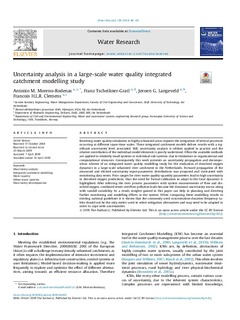| dc.contributor.author | Moreno-Rodenas, Antonio | |
| dc.contributor.author | Tscheikner-Gratl, Franz | |
| dc.contributor.author | Langeveld, Jeroen | |
| dc.contributor.author | Clemens, Francois | |
| dc.date.accessioned | 2019-04-24T12:08:04Z | |
| dc.date.available | 2019-04-24T12:08:04Z | |
| dc.date.created | 2019-04-23T08:57:07Z | |
| dc.date.issued | 2019 | |
| dc.identifier.citation | Water Research. 2019, 158 46-60. | nb_NO |
| dc.identifier.issn | 0043-1354 | |
| dc.identifier.uri | http://hdl.handle.net/11250/2595285 | |
| dc.description.abstract | Receiving water quality simulation in highly urbanised areas requires the integration of several processes occurring at different space-time scales. These integrated catchment models deliver results with a significant uncertainty level associated. Still, uncertainty analysis is seldom applied in practice and the relative contribution of the individual model elements is poorly understood. Often the available methods are applied to relatively small systems or individual sub-systems, due to limitations in organisational and computational resources. Consequently this work presents an uncertainty propagation and decomposition scheme of an integrated water quality modelling study for the evaluation of dissolved oxygen dynamics in a large-scale urbanised river catchment in the Netherlands. Forward propagation of the measured and elicited uncertainty input-parametric distributions was proposed and contrasted with monitoring data series. Prior ranges for river water quality-quantity parameters lead to high uncertainty in dissolved oxygen predictions, thus the need for formal calibration to adapt to the local dynamics is highlighted. After inferring the river process parameters with system measurements of flow and dissolved oxygen, combined sewer overflow pollution loads became the dominant uncertainty source along with rainfall variability. As a result, insights gained in this paper can help in planning and directing further monitoring and modelling efforts in the system. When comparing these modelling results to existing national guidelines it is shown that the commonly used concentration-duration-frequency tables should not be the only metric used to select mitigation alternatives and may need to be adapted in order to cope with uncertainties. | nb_NO |
| dc.language.iso | eng | nb_NO |
| dc.publisher | Elsevier | nb_NO |
| dc.rights | Navngivelse 4.0 Internasjonal | * |
| dc.rights.uri | http://creativecommons.org/licenses/by/4.0/deed.no | * |
| dc.title | Uncertainty analysis in a large-scale water quality integrated catchment modelling study | nb_NO |
| dc.type | Journal article | nb_NO |
| dc.type | Peer reviewed | nb_NO |
| dc.description.version | publishedVersion | nb_NO |
| dc.source.pagenumber | 46-60 | nb_NO |
| dc.source.volume | 158 | nb_NO |
| dc.source.journal | Water Research | nb_NO |
| dc.identifier.doi | 10.1016/j.watres.2019.04.016 | |
| dc.identifier.cristin | 1693343 | |
| dc.description.localcode | © 2019 The Author(s). Published by Elsevier Ltd. Open Access. This article is available under the terms of the Creative Commons Attribution License (CC BY). | nb_NO |
| cristin.unitcode | 194,64,91,0 | |
| cristin.unitname | Institutt for bygg- og miljøteknikk | |
| cristin.ispublished | true | |
| cristin.fulltext | original | |
| cristin.qualitycode | 2 | |

